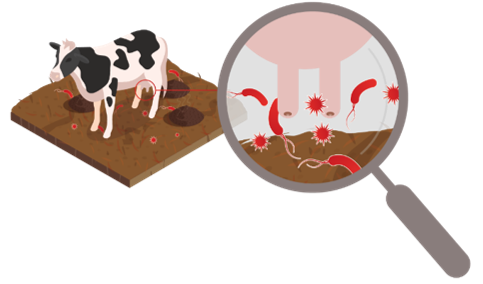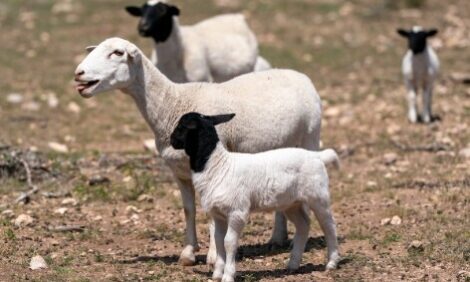



Maintaining bedding quality can benefit udder health
Dedicated microbial bedding conditioner preserves the quality of the bedding materialLallemand Animal Nutrition is pleased to share the results of a recent scientific publication showing the application of a dedicated microbial bedding conditioner preserves the quality of the bedding material and has positive outcomes on the maintenance of udder health and cow health (Dunière et al., 20241).
From bedding to udder health

Cows spend at least 12 hours per day lying down, either resting or ruminating. The microbial quality of the bedding and manure — that are in close contact with the udder for so long — is an important factor to help maintain a healthy udder and reduce the risk of environmental mastitis.
Bedding is a source of heat, moisture and organic matter. It represents a perfect environment for undesirable microorganisms such as coliforms or enterobacteria to grow.
Studies have shown a direct correlation between the number of coliforms in the bedding material and on the cow’s teats.2 This environment also can increase the risk of high somatic cell count (SCC).
An important but preventable issue
Bovine mastitis is an inflammatory response of the udder tissue due to physical trauma or microorganism infections. Mastitis is considered the most common disease in dairy cows. It negatively affects their performance, welfare and longevity as well as farm profitability. Linked to both milk production loss and treatment costs, the cost of mastitis for dairy farmers can be estimated at 277€/cow in early lactation to 168€/cow in late lactation.3 About 70% of mastitis cases are caused by bacterial infections.4
There are two types of mastitis: contagious mastitis, which is often transmitted during milking from one cow to another and usually causes subclinical mastitis; or environmental mastitis, which is caused by contamination of the udder outside of milking from environmental pathogen reservoirs such as bedding, manure and/or water. The worldwide prevalence of subclinical mastitis is estimated at 42%.5
SCCs are a useful predictor of intramammary infection.6 This metric helps assess the milk quality, hygiene and the mastitis control at herd or individual cow level.
Focusing on hygiene and mastitis prevention measures from the milking parlor to the barn — in particular at bedding management level — is important for herd health and profitability.
Did you know ?
Somatic cells are mainly white blood cells and epithelial cells from the udder tissue. White bloods cells increase in response to bacterial infection, tissue injury or stress. This explains why the number of somatic cells founded into the milk is increases when undesirable microorganisms enter the udder. Several publications show the link between high level of SCC and the incidence of mastitis in farms.
Microbial management of bedding and manure
Let’s look at cow bedding from a microbiological point of view. We know that it harbors important microbial populations, organized in ecosystems. Fortunately, most microorganisms are either beneficial or neutral to their environment. On the other hand, some undesirable ones can be pathogenic and may infect the animal. Optimizing the balance of these microbial ecosystems through bedding and manure microbial management represents a valuable solution to help maintain a safe environment for the animal.
It appears the inoculation of the bedding/manure with beneficial live bacteria and enzymes promote the development of these beneficial microorganisms to help maintain bedding quality.

A dedicated microbial bedding conditioner has been developed by Lallemand Animal Nutrition (MANURE PRO) by selecting specific lactic acid bacteria (LAB) and Bacillus strains. In addition, cellulolytic enzymes are included in the formulation to enhance fermentation and “pre-composting” of the manure. These enzymes release specific five- and six-carbon sugars from the complex sugars present. The sugars are then used as substrate and metabolized by the LAB and Bacillus strains.
Microbial inoculants should be added at a regular frequency. Weekly applications are typically sufficient. They are applied either by spraying after dilution in water or by spreading on the bedding material when they are formulated in dry bedding conditioners.
A direct link between bedding quality and the maintenance of udder health
The published study was conducted in the Czech Republic from June to September to assess the link between bedding and manure microbial inoculation (using MANURE PRO, Lallemand Animal Nutrition) to udder health and milk quality (SCC, milk flora).
Four pens of 55 cows each were used in the study: 2 pens without bedding inoculant, 2 pens with MANURE PRO.

This farm used recycled manure solids (RMS). RMS is obtained by mechanically separating manure removed from dairy cow housing systems. Its low cost of recovery, as well as wide availability, has allowed RMS to be used as an alternative source of bedding.7
While an economic and sustainable solution for dairy farms, RMS can pose a higher challenge in terms of microbial pressure on the animals (Lallemand Animal Nutrition, internal data, 2019).
Prior to the trial, the farm had an history of high mastitis prevalence, 90% of the time the disease was caused by environmental contaminants as analyzed by farm cultures. The herd experienced peaks during the summer months.
The scientists used specific omics techniques (16S amplicon sequencing) to decipher the effect of the microbial bedding conditioner on the bedding microbiota.

“Interestingly, we found that the application of the microbial bedding conditioner modified the profiles and diversity of the bedding microbiota, while the control bedding was significantly associated with potential mastitis pathogens, we did not detect such undesirable bacteria in the MANURE PRO treated RMS bedding. The bedding physio-chemical quality was also improved by the use of the bedding conditioner. When we looked at the teat skin microbiota, we made the same observations: microorganisms potentially associated with mastitis were mainly observed on the skin of the control cows and were not present in the cows from the MANURE PRO pens. In summary, the use of MANURE PRO is shown to help maintain microbial bedding quality and this is translated into lower somatic cell counts in milk!”, explains Lysiane Duniere, Ph.D., Research Scientist for Lallemand Animal Nutrition.
The study confirmed that by maintaining the bedding quality, MANURE PRO:
- Significantly helped maintain a low SCC level in milk during the summer months (Figure 1),
- Helped reduce the risk of being over 250,000 SCC by 5.3 times on average for the MANURE PRO cows vs. control (Figure 2),
- Tended to reduce the risk of environmental mastitis (Figure 3) with an overall downward trend through August,
- Had no impact on the milk microflora (both total flora of milk and spore content).

Figure 1. Effect of MANURE PRO on the SCC evolution per month.

Figure 2. Effect of MANURE PRO on the number of cows > 250K SCC/15 days.

Figure 3. Effect of MANURE PRO on the number of environmental mastitis per month, as evaluated by on-farm culture for main pathogens: E. coli, Klebsiella, Streptococcus uberis / Parauberis, Serratia monocytogenes.
Conclusion
Cows spend more than half their life lying down. There is a strong correlation between the microbial condition of the bedding material and udder health, as defined by SCC and environmental mastitis. In addition to good hygiene practices, dry cow management and milking management, the use of a bedding inoculant with live bacteria (specific LAB, Bacillus) and enzymes represents an interesting tool to help maintain bedding quality and thus ensure optimal udder health, even under conditions of high microbial pressure.
| References | ||||
|---|---|---|---|---|
| 1. Rowbotham RF, Ruegg PL. | ||||
| (2016) | Bacterial counts on teat skin and in new sand, recycled sand, and recycled manure solids used as bedding in freestalls.. J Dairy Sci. | Aug;99(8):6594-6608 | 15-10674. Epub 2016 Jun 2. doi: 10.3168/jds.20PMID: 27265163. | |
| 2. Carlos Romero | ||||
| (2019) | Improving dairy European industry | |||
| 3. Bhushan Jayarao MVSc, PhD | ||||
| Bovine Mastitis. MPH Extension Veterinarian Department of Veterinary Science Pennsylvania State University Park | ||||
| 4. rishnamoorthy P, Goudar AL, Suresh KP, Roy P | ||||
| (2021) | Global and countrywide prevalence of subclinical and clinical mastitis in dairy cattle and buffaloes by systematic review and meta-analysis.. Res Vet Sci. | May;136:561-586 | ||
| 5. Sharma N, Singh N, Bhadwal M. | ||||
| (2011) | Relationship of Somatic Cell Count and Mastitis: An Overview.. Anim Biosci | 2011;24(3):429-438 | ||
| 6. Fournel S, Godbout S, Ruel P, Fortin A, Généreux M,Côté C, Landry C, Pellerin D. | ||||
| (2019) | Production of recycled manure solids for bedding in Canadian dairy farms: I. Solid–liquid separation.. Journal of Dairy Science | Volume 102, Issue 2, 1832-1846 |




